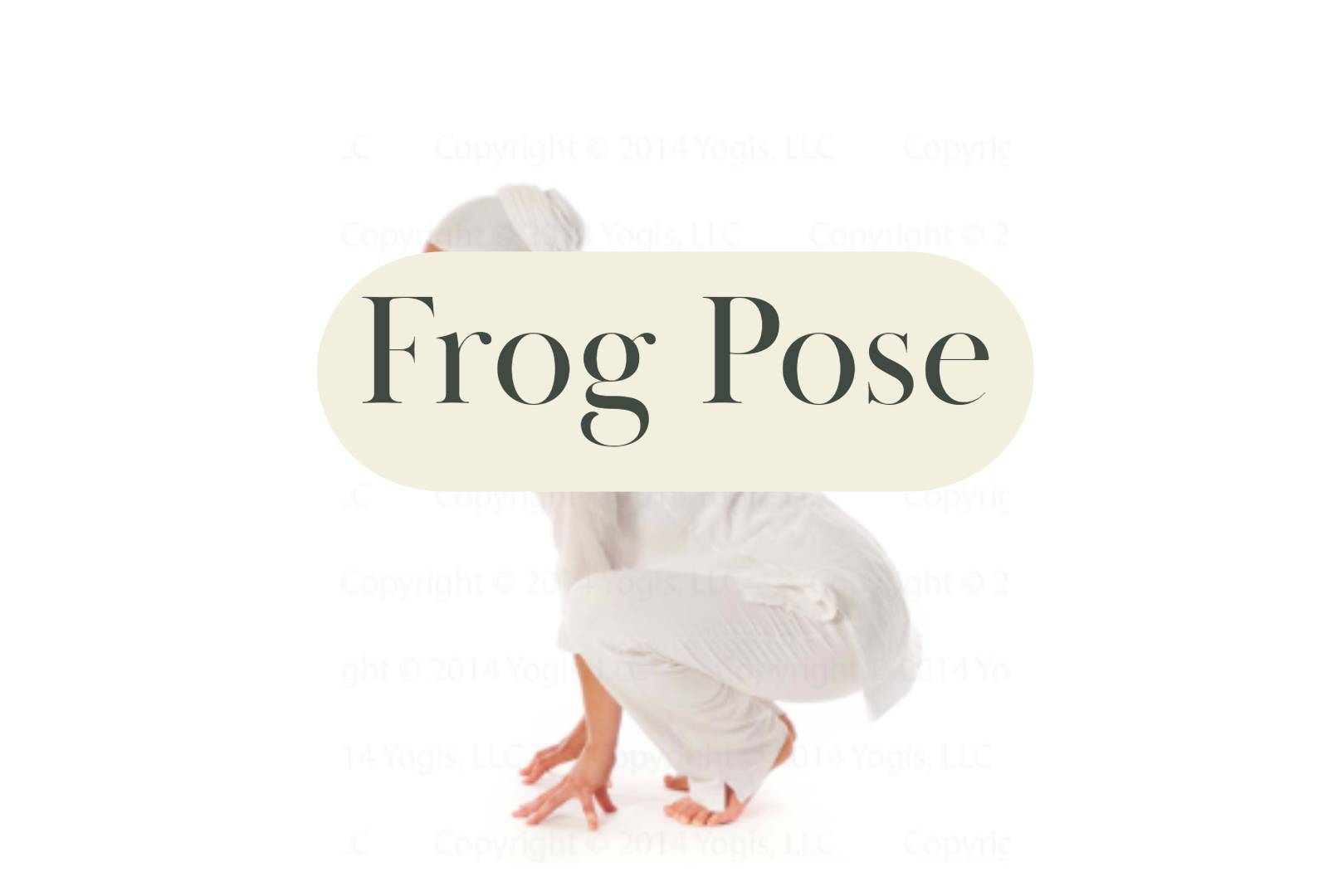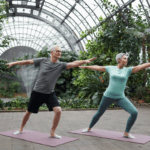Coming Soon: E-book about Kundalini Yoga - Sign up here to be among the first to get it!
Sanskrit: Mandukasana
Type: Sitting pose, Toe Balance, Squat
Chakra Involved: Root Chakra (Muladhara Chakra)
In the rich tapestry of yoga, where each asana weaves its unique pattern, the Frog Pose, or “Mandukasana” in Sanskrit (manduka means frog), occupies a special place, especially within the Kundalini Yoga tradition. This pose is not just a physical exercise; it’s a potent tool for energy activation, embodying the dynamic leap of a frog. Aimed at yoga teachers and practitioners eager to deepen their understanding and practice, this article delves into the Frog Pose’s history, benefits, anatomical focuses, and various nuances, including who might approach it with caution and how to adapt it with variations.
- Introduction to Frog Pose: The article starts by introducing Frog Pose, a dynamic Kundalini Yoga asana known for its multiple health benefits, including enhancing flexibility and aiding in digestion.
- Benefits of Frog Pose: The pose is praised for its ability to improve circulation, strengthen the lower body, enhance flexibility, and stimulate the reproductive and digestive systems. It’s also noted for aiding in emotional release and energy flow.
- Step-by-Step Guide: The article provides a detailed, step-by-step guide on how to perform Frog Pose, ensuring practitioners can safely and effectively enter, hold, and release the pose.
- Tips for Practitioners: It offers practical tips for both beginners and advanced practitioners, including modifications for those with limitations and advice on how to deepen the pose.
- Contraindications and Cautions: The article highlights important contraindications and cautions, advising those with knee, hip, or lower back issues to modify or avoid the pose to prevent injury.
- Integrating Frog Pose into Practice: Suggestions are provided on how to incorporate Frog Pose into a regular Kundalini Yoga practice for maximum benefit, emphasizing its role in awakening and energy movement.
- Testimonials and Experiences: The article includes testimonials and personal experiences from individuals who have incorporated Frog Pose into their practice, sharing insights into its transformative impact on both physical and emotional well-being.
- Conclusion: It concludes with a reflection on the holistic benefits of Frog Pose, encouraging practitioners to explore the asana as part of their journey towards physical health and spiritual awakening.
The Historical Leap of Mandukasana
Frog Pose has roots deeply embedded in the Kundalini Yoga tradition, a form of yoga focused on awakening the Kundalini energy at the base of the spine through a combination of postural, breathing, and meditation techniques. Mandukasana is revered for its ability to stimulate the lower chakras, specifically the sacral and root chakras, which are centers of creativity, passion, grounding, and stability. Historically, this pose is used not just for its physical benefits but as a means to prepare the practitioner for deeper spiritual exploration and awakening.
Anatomy and Energetic Benefits Unraveled
The Frog Pose is a dynamic asana that targets the hips, thighs, and groin, offering an intense stretch that can improve flexibility and circulation in these areas. It strengthens the lower back, enhances abdominal muscle tone, and stimulates the reproductive and digestive systems. From an energetic perspective, it’s known to release pent-up energy and emotions, fostering a sense of release and renewal.
The unique stance of the Frog Pose, with its emphasis on grounding and expansion, mirrors the balance between earthiness and aspiration, encouraging practitioners to embrace both stability and the capacity for spiritual leap.
Who Should Proceed with Caution?
Mandukasana is a powerful pose, but it’s not suitable for everyone. Individuals with knee or hip issues should approach this pose with caution or avoid it altogether. Similarly, those with lower back problems may find this pose challenging. Always listen to your body’s signals and consult with a healthcare provider if in doubt.
Starting Position
Initial Stance: Begin in a comfortable standing position, feet hip-width apart, standing tall with your arms by your sides, preparing your body and mind for the practice.
Step-by-Step Instructions
- Transition into Squat: Gradually lower yourself into a deep squat. Position your feet wider than your hips, with toes pointing outward, aligning your knees with your toes to prepare for the pose.
- Hand Placement: Lower your hands to the floor in front of you, keeping them shoulder-width apart for stability. Ensure your arms are straight, with palms flat on the ground, under your shoulders.
- Widen the Knees: Carefully widen your knees until you feel a significant yet manageable stretch in the inner thighs and groin area. This is the essence of the Frog Pose, focusing on opening and stretching the hips.
- Heel and Hip Alignment: Adjust your feet so that your heels are in line with your hips, and the insides of your feet are making contact with the floor. Flex your feet to intensify the stretch gently.
- The Dynamic Movement: Incorporate the dynamic “leaping” aspect by inhaling as you partially straighten your legs, lifting your hips towards the ceiling. Exhale as you return to the deep squat position. Repeat this movement several times to energize the pose and enhance its benefits.
To Release the Pose
Gently Exit: To come out of the Frog Pose, slowly bring your knees together, using your hands for support as needed. Transition into a Child’s Pose by sitting back on your heels, extending your arms in front of you on the ground, allowing your body a few moments of rest and recovery.
Additional Tips:
- Mindful Breathing: Throughout the pose, maintain a deep and steady breath. This will help in managing any discomfort and in staying focused.
- Listen to Your Body: It’s crucial to listen to your body’s signals and not push into pain or extreme discomfort. Frog Pose is intense, and respecting your body’s limits is key to a safe and beneficial practice.
- Use of Props: Feel free to use props such as cushions or folded blankets under your knees or hands for added support and comfort.
Variations and Modifications for an Inclusive Practice
For Beginners or Those with Tight Hips:
- Supported Frog Pose: Place a cushion or folded blanket under your knees and hands for additional support. This reduces the intensity of the stretch in the hips and makes the pose more accessible.
For Advanced Practitioners:
- Deep Frog Pose: Increase the distance between your knees gradually, challenging your flexibility. Ensure this is done slowly and mindfully to avoid any strain.
Teacher’s Tips for a Fulfilling Practice
- Focus on Breath: Encourage students to maintain a steady, rhythmic breath throughout the practice. The breath is a powerful tool to deepen the pose and maintain focus.
- Promote Mindfulness: Remind students to listen to their bodies and not push beyond their limits. The goal is not to achieve the perfect pose but to explore their current boundaries gently.
- Individual Adjustments: Be attentive to individual needs. Use props and modifications to make the pose accessible to everyone in the class.
- Integrate Intention: Invite students to set an intention for their practice, focusing on the energetic release and renewal that Frog Pose facilitates. This can enhance the spiritual dimension of their practice.
Embracing the Leap
Mandukasana, with its rich blend of physical challenge and energetic stimulation, offers a unique opportunity to explore the depths of one’s practice. It reminds us of the balance between grounding and aspiration, stability and transformation. As yoga teachers and practitioners, integrating the Frog Pose into our practice and teachings can help us and our students to unlock new dimensions of strength, flexibility, and spiritual awakening.
FAQs about Kundalini Frog Pose
Frog Pose in Kundalini Yoga is known for its multitude of benefits, including improving flexibility in the hips, ankles, and thighs. It stimulates the abdominal organs, enhancing digestion and metabolism. This pose also strengthens the lower back, improves circulation in the pelvic region, and can help release pent-up emotions or stress stored in the hips.
In Kundalini Yoga, Frog Pose is often associated with transformation and cleansing. Frogs symbolize rebirth and renewal due to their lifecycle transitions from tadpole to frog, mirroring the spiritual journey of transformation. Practicing Frog Pose is believed to awaken one’s inner energy, promote emotional cleansing, and facilitate spiritual growth.
Physically, Frog Pose opens up the hips, stretches the inner thighs, and strengthens the legs, back, and core. It also increases circulation and flexibility in the pelvic area. On an energetic level, it stimulates the sacral chakra, which governs creativity, pleasure, and relationships, promoting emotional balance and releasing blockages.
Frog Pose is intense because it deeply stretches the inner thighs and groins, areas of the body that are often tight due to sedentary lifestyles. The pose requires and develops flexibility in the hips and thighs, which can be challenging for many people. The intensity also comes from holding the pose and breathing through the discomfort, encouraging mental and physical endurance.
Practicing Frog Pose daily can lead to significant improvements in flexibility, particularly in the hips and inner thighs. Over time, it can also enhance your emotional well-being by releasing emotional blockages and promoting a sense of balance and grounding. Regular practice may improve digestion and circulation, contribute to a stronger core, and facilitate a deeper connection with one’s inner self. However, as with any intense yoga pose, it’s important to listen to your body and allow for rest days to prevent overexertion or injury.




